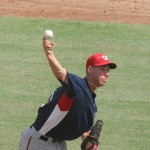Well, it isn’t like I didn’t have enough content to publish this week (with 7 seasonal reviews coming out, each of them between 1500 and 3000 words). But Nats mlb.com beat reporter Bill Ladson had to come out with an inbox on 12/19/13, so lets do some rare weekend posting so we can talk about the system-wide pitching staff projections on monday.
As always, these are real questions from (presumably) real people. I write my response here before reading his to avoid bias, and edit questions for clarity. Here we go:
Q: Are the Nationals done as far as improving the team for next year?
A: I don’t think so: I still see a veteran catcher, a better backup infielder, and another lefty in the pen as possible acqusitions. On my little “off-season Nats todo-list” the only one of these that I think *must* happen is the backup catcher. Per mlbtraderumors.com 2014 FA Tracker I see some names still out there that could work: John Buck i’ve heard in rumors somewhere, and someone like Kelly Stoppach could work. Honestly I havn’t done a ton of research on veteran backup catchers, so these may be awful suggestions.
Right now whose your backup infielders? Are you ready to go to war with either Zach Walters or Danny Espinosa in that role? Steve Lombardozzi got 300+ plate appearances in 2013, more the year before. Jerry Hairston got 238 PAs in 2011 while Alex Cora ot 172. Basically the point is this: your backup infielder is going to get a LOT of at-bats. You need to have someone reliable. I would not entirely call either Walters (lack of experience) or Espinosa (apparent lack of capability) proven right now.
I don’t see the need to go all out for another lefty reliever, but i’m also not Mike Rizzo. We have some options internally that we could use.
Ladson mentions middle infield and a backup catcher as well, and then surprises me with his mention of Shin-Soo Choo, a personal favorite of mine who I’d love to see here hitting lead-off and playing LF in the short-term. But not in center, where he proved he was awful last year, and not for 7 years and 9-figures like he seems to be set to get. I’d be absolutely shocked if the Nats committed those kind of dollars for Choo, given his age and likely fall-off.
Q: With MLB looking to ban home-plate collisions, could you see the Nats giving Bryce Harper a chance behind the plate if Wilson Ramos can’t stay healthy?
A: No way. It isn’t just about collisions; its the wear and tear, its taking a guy’s bat out of the lineup once or twice a week. Harper was never going to be a full time catcher, not with his once-in-a-generation premium bat. Ladson agrees.
Q: Do you think pitchers Nathan Karns, Lucas Giolito and A.J. Cole will be used in spot starts this season?
A: Karns yes, Cole doubtful and Giolito no way. It all comes down to 40-man roster manipulations. Right now Karns is on the roster so he can get called up and down every week and it has no effect on anything but his service time accumulation (which teams have shown lately that they’re less and less concerned about). Cole, if he dominates in AA could see a similar call-up to what Taylor Jordan and Karns got last year … except that the team has significantly more starter depth this year. Maybe Cole can be a 9/1/13 call-up; he is rule-5 eligible after the 2014 season and will have to be added to the 40-man roster anyway. As for Giolito, there’s just no way he’s sniffing the majors until he’s ready. Right now he’s the prize asset in the farm system and he needs to develop so that he can arrive in the majors right as the team needs to make some key decisions on personnel. Ladson agrees.
Q: Could you please explain to me why Zach Walters is only No. 11 on the list of the Nats’ top prospects? The numbers he put up last season are pretty amazing.
A: Mostly people seem to be concerned about his OBP, which has dropped at every level and was only .286 in Syracuse last year. He has always struck out a ton; 134 in 134 games last year, more or less averaging a K/game for his ML career. That being said … you don’t find guys who can hit 29 homers and play Shortstop on trees. And last I checked, you trade off some OBP and some excessive K’s for guys who can hit a ton of bombs. Maybe scouts are just in denial. Lots of people think the team should flip him now based on his 2013 season, but if he can do anything close to those numbers in the majors he’s doubly-valuable. Ladson thinks he’ll be ranked much higher in the 2014 rankings.
Q: Who do you think will win the fifth spot in the Nationals’ rotation?
A: That’s the question of the off-season. We’ve argued about it over and again here, and will again next week when I post system-wide predictions. We’ll save the arguments for then. Ladson says Tanner Roark, which surprises me frankly. Lets save arguments on this for my big prediction piece next week.
Q: Do you think Espinosa will be a valuable backup for the Nats?
A: Boy I hope so. But something holds me back; what has changed from the point he was demoted til now? He hasn’t gotten his shoulder fixed. He hasn’t stopped switch hitting. All he did was go to Syracuse and continue to hit poorly. Why at this point would we think he’s going to do anything better than what he’s already shown us he can do? Ladson expresses some doubts too.




